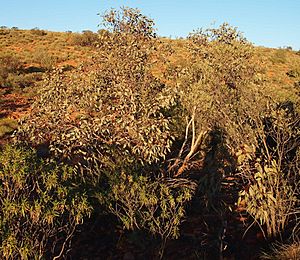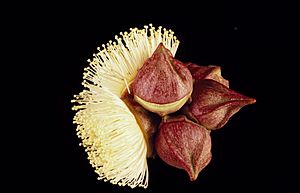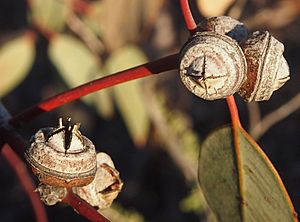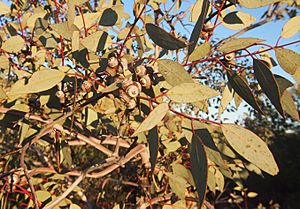Finke River mallee facts for kids
Quick facts for kids Finke River mallee |
|
|---|---|
 |
|
| Eucalyptus sessilis habit | |
| Scientific classification | |
| Genus: |
Eucalyptus
|
| Species: |
sessilis
|
| Synonyms | |
|
Eucalyptus pachyphylla var. sessilis |
|
The Finke River mallee (scientific name: Eucalyptus sessilis) is a special type of eucalyptus tree. It's also called the red bud mallee or river mallee. This tree grows naturally in Australia, mainly in the Northern Territory. You can also find it in central areas near the border of Western Australia.
This mallee has smooth bark. Sometimes, you might see old bark hanging like ribbons near its base. Its leaves are shaped like a spear or an egg. The tree produces flower buds in groups of seven. When they bloom, the flowers are a lovely creamy yellow color. After flowering, it grows round, woody fruits.
Contents
What the Finke River Mallee Looks Like
The Eucalyptus sessilis is a type of mallee. This means it's a shrubby tree with many stems growing from the ground. It usually spreads out and can grow to be about 2 to 5 meters (6.5 to 16 feet) tall. It also has a special woody swelling at its base called a lignotuber. This helps the plant regrow after a fire.
Bark and Leaves
The bark of this mallee is smooth and grey. It peels off in long strips or ribbons. Sometimes these ribbons gather at the bottom of the stems.
Young plants have leaves shaped like an egg or a wide spear. These leaves are about 12 to 16 centimeters (4.7 to 6.3 inches) long. They are also about 5 to 6 centimeters (2 to 2.4 inches) wide.
As the plant gets older, its leaves change. Adult leaves grow one after another along the stem. They are dull green to grey-green on both sides. These leaves are 6 to 15 centimeters (2.4 to 5.9 inches) long. They are 1.7 to 6.2 centimeters (0.7 to 2.4 inches) wide. Each leaf has a stalk called a petiole, which is 1.7 to 4.2 centimeters (0.7 to 1.7 inches) long.
Flowers and Fruit
The flower buds grow in groups of seven. They appear where the leaves meet the stem. Each group of buds sits on a thick, unbranched stalk called a peduncle. This stalk is 4 to 10 millimeters (0.16 to 0.39 inches) long. The individual buds are usually attached directly without a small stalk.
Mature buds are a claret (reddish-purple) color. They are oval or round, about 1.8 to 2.5 centimeters (0.7 to 1 inch) long. They are also 1 to 1.6 centimeters (0.4 to 0.6 inches) wide. These buds have ridges along their sides. They also have a beaked cap called an operculum.
The Finke River mallee flowers between April and July. Its flowers are a beautiful yellow-cream color. After flowering, the tree produces a woody fruit. This fruit is usually round and shaped like half a sphere. It's about 0.6 to 1.3 centimeters (0.24 to 0.51 inches) long. It's also 1.4 to 2.3 centimeters (0.55 to 0.91 inches) wide. The fruit has a raised center and four parts that stick out. Inside, the seeds are grey-brown to blackish. They are shaped like a flattened pyramid or a cube.
How the Finke River Mallee Got its Name
The Finke River mallee was first officially described in 1920. A botanist named Joseph Maiden gave it the name Eucalyptus pachyphylla var. sessilis. He wrote about it in his book, A Critical Revision of the Genus Eucalyptus.
The first plant sample was collected in 1872. It was found by Ernest Giles in the western Macdonnell Range. Later, in 1934, another botanist, William Blakely, changed its name. He decided it was a separate species and called it E. sessilis. He published this in his book, A Key to the Eucalypts.
The scientific name sessilis (pronounced SESS-il-iss) describes a special feature of the plant. It means "without a stalk." This refers to how the flower buds and fruits are directly attached to the stem.
Where the Finke River Mallee Grows
The Eucalyptus sessilis grows in open shrublands. You can often find it on rocky slopes. It lives in the central part of the Northern Territory, especially around Alice Springs.
It also grows west of the Northern Territory border. You can find it in the Goldfields-Esperance region of Western Australia. This mallee is most common on rocky mountain ranges. These include the MacDonnell Ranges and Central Ranges in the Northern Territory. In Western Australia, it grows in the Rawlinson Ranges and Walter James Range. It is also found scattered through the Finke River basin, the Great Sandy Desert, and the Burt Plains.
Protecting the Finke River Mallee
Good news! The Finke River mallee is not considered to be in danger. The Northern Territory Government classifies it as "least concern." This means there are plenty of these plants around. The Western Australian Government also says it is "not threatened." This shows that efforts are being made to protect this unique tree.
Growing the Finke River Mallee
This mallee is a tough plant. It can handle both dry weather and cold frosts. It's a great plant for gardens because it attracts birds. It grows well in full sun or in places with some shade.




